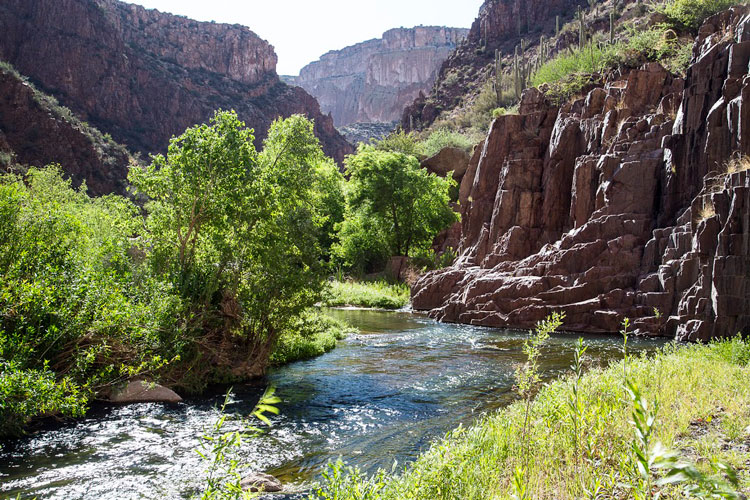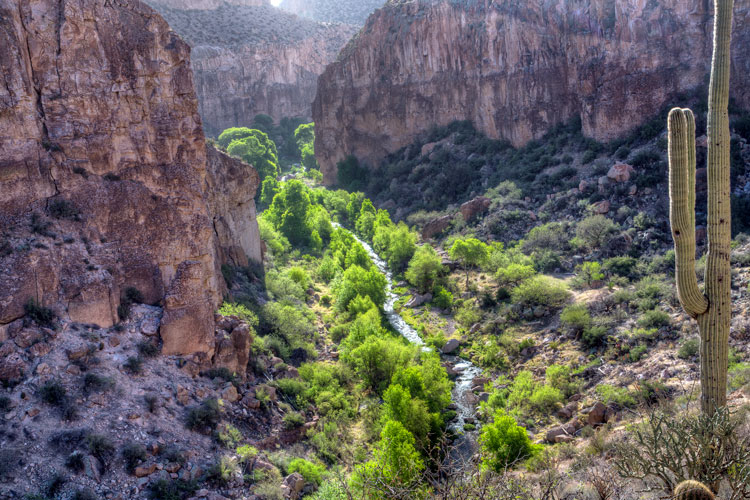Photo By June Lowery: The 2018/19 Gila Valley Leadership Class visits the Aravaipa Canyon Wilderness.
Day includes tour of Aravaipa Canyon Wilderness
Contributed Article By June Lowery/BLM Gila District Public Affairs Specialist
The 2018-2019 Gila Valley Leadership class attended a recent field day hosted by the BLM’s Safford Field Office to learn about public land management, including a site visit to a southeastern Arizona wilderness area.
The Safford Field Office has been a part of the Graham County Chamber of Commerce’s leadership program since its inception in 2005 and sends up to two interested employees through the 12-week course each year.

“The course allows our staff to learn about the industries in Graham County and build networking relationships with others,“ said Field Manager Scott Cooke. “It also gives others in our community a better understanding of what we do as stewards of their public lands.”
The Safford Field Office has a small staff complement that partners with local, state and other federal agencies, mining, utility and grazing industries, conservation groups, law enforcement entities, and individual landowners to ensure that public land management represents all land users.
Cooke presented an overview of the field office’s responsibilities, which includes managing 1.3 million acres of public land under the multiple-use and sustained yield mission. “We have to consider a variety of uses while we ensure that the land remains in good condition for the future,” Cooke said. “Our office also manages lands that have been designated for their conservation values such as the Gila Box Riparian National Conservation Area and the Aravaipa Canyon Wilderness.”
The class also learned about the BLM’s unmanned aerial systems (UAS), law enforcement, range, and fire programs.
The rest of the day was spent in the Aravaipa Canyon Wilderness, part of the BLM’s National Landscape Conservation System. Designated for protection by Congress, Aravaipa’s 19,410 acres of outstanding scenery, desert fish and wildlife, rich history and opportunities to recreate in solitude make it a unique treasure. Members of the class commented on the beauty and pristine nature of the area. “It is amazing that we have this beautiful place in our backyard,” said Graham County Chamber of Commerce Director Micah Windsor.

Approximately 4,700 people visit the Aravaipa Canyon Wilderness each year,” Associate Field Manager Tom Schnell said. Visitors arrange their visit through an online permit system through recreation.gov. BLM Partner, The Nature Conservancy (TNC), has owned property adjacent to the Aravaipa Canyon Wilderness since 1971. Employee Mark Haberstitch talked to the group about the seven native fish species that reside in Aravaipa, all of which the U.S. Fish and Wildlife Service has listed as either threatened or endangered. He also talked about the BLM-TNC partnership to remove non-native fish from the creek and help the native fish populations thrive. “Native fish are important to the area as they are an indicator that the water is healthy,” said Haberstitch. “The Non-native fish eat the native fish and take away their food supply so we have to remove them.”
TNC holds grazing leases in the area and helps ranchers get funding to reestablish grasslands. The native grasses also help sustain native wildlife in the Aravaipa area.
Park Ranger Heidi Blankenship and Wildlife Biologist Mark McCabe talked about the native plants and animals that live in the Aravaipa Canyon Wilderness. “This wilderness is part of the Sky Islands,” said Blankenship. “It located in the Sonoran and Chihuahuan deserts and contains year round creek flows for about 23 miles, making it a very unique landscape.”

The last stop in Aravaipa was a visit to a Puebloan time-period cliff dwelling. The Pueblo inhabited the area from 1275-1450 A.D. “There is a long history of human occupation in the Aravaipa area,” shared McGrew.
The class enjoyed the day in the Aravaipa Canyon Wilderness and learned a lot about the BLM’s mission to manage the public land for the American people for a variety of uses while ensuring the land’s sustainability for future generations.








